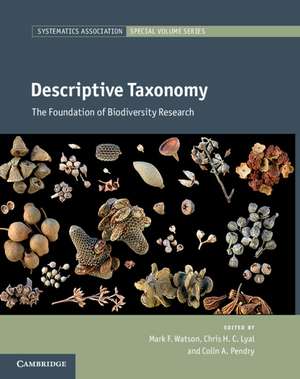Descriptive Taxonomy: The Foundation of Biodiversity Research: Systematics Association Special Volume Series, cartea 84
Editat de Mark F. Watson, Chris H. C. Lyal, Colin A. Pendryen Limba Engleză Hardback – 7 ian 2015
Preț: 792.75 lei
Preț vechi: 921.81 lei
-14% Nou
Puncte Express: 1189
Preț estimativ în valută:
151.71€ • 157.80$ • 125.25£
151.71€ • 157.80$ • 125.25£
Carte tipărită la comandă
Livrare economică 14-28 aprilie
Preluare comenzi: 021 569.72.76
Specificații
ISBN-13: 9780521761079
ISBN-10: 0521761077
Pagini: 339
Ilustrații: 36 b/w illus. 11 colour illus. 6 tables
Dimensiuni: 194 x 253 x 20 mm
Greutate: 0.91 kg
Editura: Cambridge University Press
Colecția Cambridge University Press
Seria Systematics Association Special Volume Series
Locul publicării:Cambridge, United Kingdom
ISBN-10: 0521761077
Pagini: 339
Ilustrații: 36 b/w illus. 11 colour illus. 6 tables
Dimensiuni: 194 x 253 x 20 mm
Greutate: 0.91 kg
Editura: Cambridge University Press
Colecția Cambridge University Press
Seria Systematics Association Special Volume Series
Locul publicării:Cambridge, United Kingdom
Cuprins
List of contributors; Introduction M. F. Watson and C. Lyal; Part I. The Widening Audience: 1. Floras yesterday, today and tomorrow A. G. Miller, M. Hall, M. F. Watson, S. G. Knees, C. Pendry and M. R. Pullan; 2. Current uses and future perspectives for conservation biology B. Collen; 3. The present and future value of Floras for functional ecologists J. Dick, R. Smith and R. Wadsworth; 4. A publisher's perspective: making biodiversity information available and relevant to a wide audience J. Connor; Part II. The Products of Descriptive Taxonomy: 5. Lessons learned from two projects, the Fauna Europaea and the Checklist delle specie della fauna italiana A. Minelli; 6. Flora Europaea and Euro+Med S. L. Jury; 7. Increasing the utility of the regional African Floras D. W. Kirkup, P. Malcolm and A. Paton; 8. Cybertruffle: an on-line resource for mycology D. W. Minter; 9. Zooplankton Identification Manual for North European Seas (ZIMNES) L. C. Hastie; 10. A field guide to the dragonflies and damselflies of Britain and Ireland S. J. Brooks; 11. Sangha Trees: an identification and training guide to the trees of the northern Republic of Congo A. H. Wortley and D. J. Harris; 12. Millennium Seed Bank collector guides D. Hopkins; 13. Training in tropical plant identification D. J. Harris, S. Bridgewater and J.-M. Moutsamboté; 14. Field identification of vectors and pathogens of military significance A. G. Gutierrez; Part III. The Influence of Technology on Data Gathering in the Field: 15. The changing role of collections and field research S. Knapp; 16. Field methods for inventorying insects C. L. Häuser and K. Riede; 17. From seabed to world wide web: an overview of marine zoological sampling, data processing and potential production of digital marine faunas A. L. Allcock and M. Ryan; 18. Advancements in electronic data capture for botanical field research in temperate regions M. F. Watson, A. G. Miller, M. R. Pullan, C. Pendry and S. G. Knees; Part IV. New Technologies: Their Current Use and Future Potential: 19. Extending floras and faunas to include users' views A. L. Weitzman and C. Lyal; 20. Taxa, taxon names and globally unique identifiers in perspective R. Hyam; 21. E-publishing descriptive taxonomy: the convergence of taxonomic journals and databases V. S. Smith; 22. DNA barcoding in floral and faunal research S. E. Miller; Index.
Recenzii
'An informative collection of emerging issues and cutting-edge technology in taxonomy and biodiversity assessment … With contributions from 47 biodiversity and taxonomy experts in the UK (plus the US and Ireland), the book describes the challenges related to communicating taxonomy to a wider audience (e.g., through digital field guides); guiding the increased use of genetic information in both taxonomy and conservation; and identifying taxonomic trends impacting biodiversity assessment and conservation. Clearly the gap between taxonomists and conservationists can be closed through the movement toward digitization, online access to collections and checklists, and open access and Creative Commons copyright practices … This book will be particularly beneficial for researchers who develop or use assessment or monitoring tools.' A. L. Mayer, Choice
'A recommended text for those working in taxonomy and searching for an accessible update on current practices.' Paul Ashton, The Biologist
'A recommended text for those working in taxonomy and searching for an accessible update on current practices.' Paul Ashton, The Biologist
Descriere
Taking a multidisciplinary approach, this book explores how new technologies are facilitating more effective collection and dissemination of taxonomic data.






















